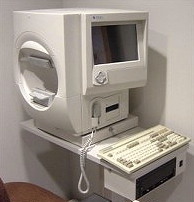The Difference Between a Vision Screening and a Comprehensive Eye Examination
What Is a Vision Screening?
A vision screening is a relatively short examination that can indicate a vision problem or a potential vision problem. A vision screening cannot diagnose exactly what is wrong with your eyes; instead, it can indicate that you should make an appointment with an ophthalmologist or optometrist for a more comprehensive dilated eye examination.
However, there is no clear evidence about the accuracy and effectiveness of a vision screening for open-angle glaucoma (U.S. Preventive Services Task Force, 2013). A comprehensive dilated eye exam is the most effective detection method for glaucoma.
What Is a Comprehensive Dilated Eye Examination?
A comprehensive dilated eye examination generally lasts between 30 and 60 minutes and is performed by an ophthalmologist or optometrist. It should always include the following components:
1. A Health and Medication History
- Your overall health and that of your immediate family
- The medications you are taking (both prescription and over-the-counter)
- Questions about high blood pressure (hypertension), diabetes, smoking, and sun exposure.
2. A Vision History
- How well you can see at present, including any recent changes in your vision
- Eye diseases that you or your family members have had, including macular degeneration and glaucoma
- Previous eye treatments, surgeries, or injuries
- The date of your last eye examination
As part of the vision history, the doctor may ask you the following questions:
- Are you having any problems with your vision?
- How long have you had these problems?
- When do these problems occur?
- When was your last eye examination?
- Do you have any family history of eye problems?
- How is your general health?
- What medications are you taking?
- Do you have any allergies?
This history of your own health and that of your family can give the doctor an indication of any issues that may be affecting or could affect, your vision.
3. An Eye Health Evaluation
- An examination of the external parts of your eyes: the whites of the eyes, the iris, pupil, eyelids, and eyelashes.
- A dilated eye (or fundus) examination that can be achieved with special lenses will allow your doctor to see inside your eye and examine the retina and optic nerve. Your doctor might use eye drops to see the retina and optic nerve more clearly.
- A test of the fluid pressure within your eyes to check for the possibility of glaucoma.
4. A Refraction, or Visual Acuity Testing

A refraction helps determine the sharpness or clarity of your near (reading) and distance vision.
This includes testing your vision with different lenses (sometimes contained in a machine called a phoropter, pictured at right) to determine if your vision can be improved or corrected with regular glasses or contact lenses.
5. Visual Field Testing
Visual field testing helps determine how much side (or peripheral) vision you have and how much surrounding area you can see.

The most common type of visual field test in a comprehensive eye exam is called a confrontation field test, in which the doctor briefly flashes several fingers in each of the four quadrants (above, below, right, and left) of your visual field while seated opposite you.
Sometimes, your doctor may also want to perform a more precise visual field measurement, using a computerized visual field analyzer, such as the Humphrey Field Analyzer (pictured at left).
6. Your Examination Results
The doctor will be able to determine if the visual problems you are experiencing are normal age-related changes or are disease-related and if additional testing, referral to another doctor or specialist, or treatments are needed.
Locate an Eye Care Professional in Your Area
By Maureen A. Duffy, M.S., CVRT